人工智能实验报告
姓名:
学号:
班级:
实验时间:
蚁群算法
实验原理:
蚂蚁在觅食过程中可以找出巢穴到食物源的最短路径,为什么?
(1)信息素(pheromone)
(2)正反馈现象:某一路径上走过的蚂蚁越多,则后来者选择该路径的概率就越大。
(3)挥发现象:路径上的信息素浓度会随着时间推进而逐渐衰减。
蚁群算法的缺点:
1)收敛速度慢
2)易于陷入局部最优
改进:
1)采用局部优化,设计了三种优化算子。
2)采用蚁群优化算法。
3)其它优化算法
实验内容:
旅行商问题(TSP,traveling salesman problem):
一商人去n个城市销货,所有城市走一遍再回到起点,使所走路程最短。
实验步骤:
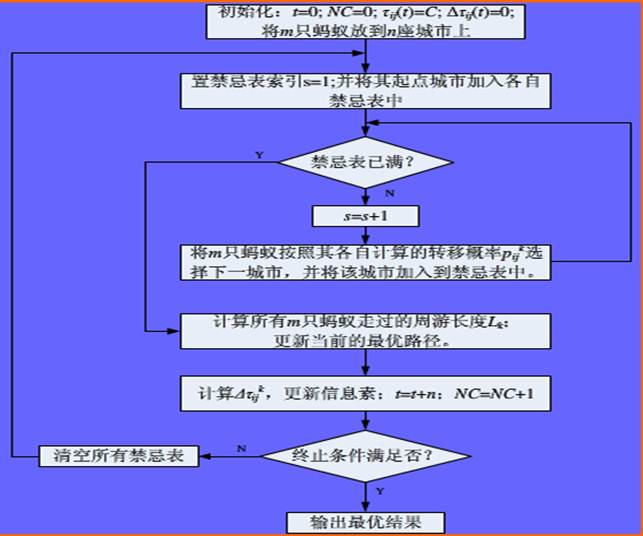
算法代码:
%%蚁群算法的优化计算——旅行商问题(TSP)优化
%% 清空环境变量
clear all
clc
%% 导入数据
load citys_data.mat
%% 计算城市间相互距离
n = size(citys,1);
D = zeros(n,n);
for i = 1:n
for j = 1:n
if i ~= j
D(i,j) = sqrt(sum((citys(i,:) - citys(j,:)).^2));
else
D(i,j) = 1e-4;
end
end
end
%% 初始化参数
m = 50; % 蚂蚁数量
alpha = 1; % 信息素重要程度因子
beta = 5; % 启发函数重要程度因子
rho = 0.1; % 信息素挥发因子
Q = 1; % 常系数
Eta = 1./D; % 启发函数
Tau = ones(n,n); % 信息素矩阵
Table = zeros(m,n); % 路径记录表
iter = 1; % 迭代次数初值
iter_max = 200; % 最大迭代次数
Route_best = zeros(iter_max,n); % 各代最佳路径
Length_best = zeros(iter_max,1); % 各代最佳路径的长度
Length_ave = zeros(iter_max,1); % 各代路径的平均长度
%% 迭代寻找最佳路径
while iter <= iter_max
% 随机产生各个蚂蚁的起点城市
start = zeros(m,1);
for i = 1:m
temp = randperm(n); %返回n个[0, n]间的随机元素向量
start(i) = temp(1);
end
Table(:,1) = start;
% 构建解空间
citys_index = 1:n; %访问1~n这n个城市
% 逐个蚂蚁路径选择
for i = 1:m
% 逐个城市路径选择
for j = 2:n %各个蚂蚁都需要访问n-1个城市
tabu = Table(i,1:(j - 1)); % 已访问的城市集合(禁忌表)
allow_index = ~ismember(citys_index,tabu); %判断citys_index中元素有没有在tabu中出现,出现用1表示,否则用0表示。
allow = citys_index(allow_index); % 待访问的城市集合
P = allow;
% 计算城市间转移概率
for k = 1:length(allow)
P(k) = Tau(tabu(end),allow(k))^alpha * Eta(tabu(end),allow(k))^beta;
end
P = P/sum(P);
% 轮盘赌法选择下一个访问城市
Pc = cumsum(P); %返回矩阵不同维数的累加
target_index = find(Pc >= rand); %选择下一个访问城市,往往转移概率大的城市被选中的概率也更大。
target = allow(target_index(1));
Table(i,j) = target; %已选定的下一个待访问城市
end
end
% 计算各个蚂蚁的路径距离
Length = zeros(m,1);
for i = 1:m
Route = Table(i,:);
for j = 1:(n - 1)
Length(i) = Length(i) + D(Route(j),Route(j + 1));
end
Length(i) = Length(i) + D(Route(n),Route(1)); %构成环
end
% 计算最短路径距离及平均距离
if iter == 1
[min_Length,min_index] = min(Length);
Length_best(iter) = min_Length;
Length_ave(iter) = mean(Length);
Route_best(iter,:) = Table(min_index,:); %Table,访问城市列表,也就是路径记录表
else
[min_Length,min_index] = min(Length);
Length_best(iter) = min(Length_best(iter - 1),min_Length);
Length_ave(iter) = mean(Length);
if Length_best(iter) == min_Length
Route_best(iter,:) = Table(min_index,:);
else
Route_best(iter,:) = Route_best((iter-1),:);
end
end
% 更新信息素
Delta_Tau = zeros(n,n);
% 逐个蚂蚁计算
for i = 1:m
% 逐个城市计算
for j = 1:(n - 1)
Delta_Tau(Table(i,j),Table(i,j+1)) = Delta_Tau(Table(i,j),Table(i,j+1)) + Q/Length(i);
end
Delta_Tau(Table(i,n),Table(i,1)) = Delta_Tau(Table(i,n),Table(i,1)) + Q/Length(i);
end
Tau = (1-rho) * Tau + Delta_Tau; %所有蚂蚁在各连接路径上的信息素浓度,不同迭代层间有关联
% 迭代次数加1,清空路径记录表
iter = iter + 1;
Table = zeros(m,n);
end
%% 结果显示
[Shortest_Length,index] = min(Length_best);
Shortest_Route = Route_best(index,:);
disp(['最短距离:' num2str(Shortest_Length)]);
disp(['最短路径:' num2str([Shortest_Route Shortest_Route(1)])]);
%% 绘图
figure(1)
plot([citys(Shortest_Route,1);citys(Shortest_Route(1),1)],...
[citys(Shortest_Route,2);citys(Shortest_Route(1),2)],'o-');
grid on
for i = 1:size(citys,1)
text(citys(i,1),citys(i,2),[' ' num2str(i)]);
end
text(citys(Shortest_Route(1),1),citys(Shortest_Route(1),2),' 起点');
text(citys(Shortest_Route(end),1),citys(Shortest_Route(end),2),' 终点');
xlabel('城市位置横坐标')
ylabel('城市位置纵坐标')
title(['蚁群算法优化路径(最短距离:' num2str(Shortest_Length) ')'])
figure(2)
plot(1:iter_max,Length_best,'b',1:iter_max,Length_ave,'r:')
legend('最短距离','平均距离')
xlabel('迭代次数')
ylabel('距离')
title('各代最短距离与平均距离对比')
实验结果:
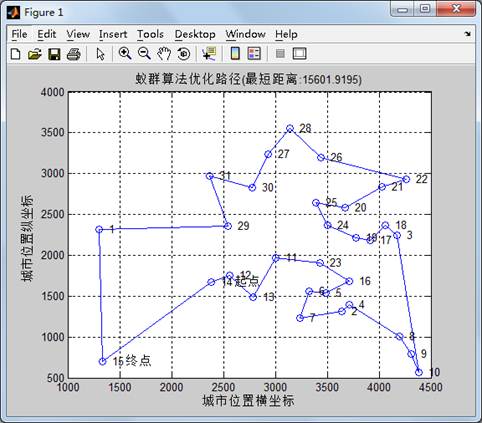
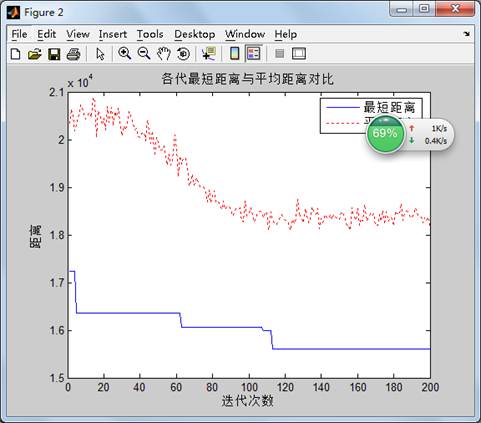
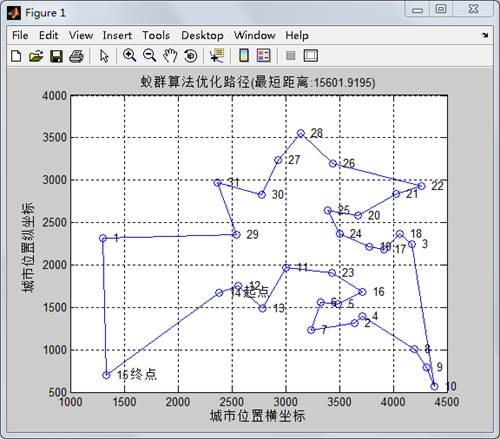
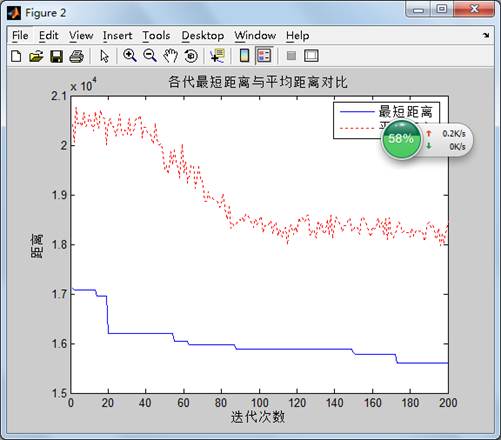
第二篇:人工智能
昆明理工大学信息工程与自动化学院学生实验报告
( 2013 — 2014 学年第 1 学期)
课程名称:人工智能 开课实验室:信自楼计算机机房442 2013 年12月 20日

一、上机目的及内容
1.上机内容
根据下列给定的14个数据,运用Information Gain构造一个天气决策树。
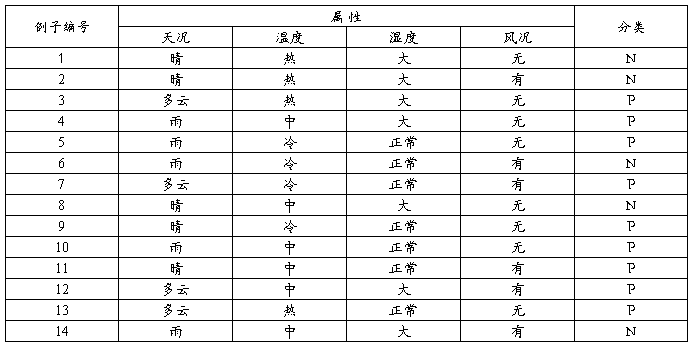
2.上机目的
(1)学习用Information Gain构造决策树的方法;
(2)在给定的例子上,构造出正确的决策树;
(3)理解并掌握构造决策树的技术要点。
二、实验原理及基本技术路线图(方框原理图或程序流程图)
(1)设计并实现程序,构造出正确的决策树;

(2)对所设计的算法采用大O符号进行时间复杂性和空间复杂性分析;
决策树通过把实例从根节点排列到某个叶子节点来分类实例,叶子节点即为实例所属的分类。树上的每一个节点说明了对实例的某个属性的测试,并且该节点的每一个后继分支对应于该属性的一个可能值。
构造好的决策树的关键在于如何选择好的逻辑判断或属性。对于同样一组例子,可以有很多决策树能符合这组例子。人们研究出,一般情况下或具有较大概率地说,树越小则树的预测能力越强。要构造尽可能小的决策树,关键在于选择恰当的逻辑判断或属性。由于构造最小的树是NP-难问题,因此只能采取用启发式策略选择好的逻辑判断或属性。用信息增益度量期望熵最低,来选择分类属性。
算法实现:
天气数据存放在data.txt 中;
第一行为样本数量14和每个样本中属性的数量4; 第二行为每个属性取值的数量; 后面n行皆为例子; 节点数据结构 struct DTNode {
int name; //用 1,2,3,4表示选择的属性,0表示不用分类,即叶节点
int data[D_MAX+1]; //表示此节点包含的数据,data[i]=1,表示包含二维数组data[][]中的第i条数据
int leaf; //leaf=1 正例叶节点;leaf=2 反例叶节点;leaf=0不是节点
int c; //c=1 正类 ;c=0 反类
DTNode *child[P+1]; //按属性值的个数建立子树 };
定义函数:
void Read_data() //从数据文件data.txt中读入训练数据
DT_pointer Create_DT(DT_pointer Tree,int name,int value) //创建决策树
int chose(int *da) //选择分类属性
float Gain(int *da,int p) //计算以p属性分类的期望熵
float Entropy(int *da) //计算数据的熵
int test_leaf(int *da) //测试节点属性
void Out_DT(DT_pointer Tree) //用线性表形式输出建立的决策树
int Class(int *da) //对输入的测试样本分类
全局变量:
FILE *fp;
int p_num; //属性的数量
int pi[P_MAX+1]; //每个属性有几种取值
int d_num; //数据的数量
int data[P_MAX+1][D_MAX+1];//存储训练数据
三、所用仪器、材料(设备名称、型号、规格等或使用软件)
1台PC及VISUAL C++6.0软件
四、实验方法、步骤(或:程序代码或操作过程)
源代码:
main函数:
#include <fstream>
#include <iostream>
#include <list>
#include <sstream>
#include <string>
#include <vector>
#include "AttributeValue.h"
#include "DataPoint.h"
#include "DataSet.h"
DataPoint processLine(std::string const& sLine)
{
std::istringstream isLine(sLine, std::istringstream::in);
std::vector<AttributeValue> attributes;
// TODO: need to handle beginning and ending empty spaces.
while( isLine.good() )
{
std::string rawfield;
isLine >> rawfield;
attributes.push_back( AttributeValue( rawfield ) );
}
AttributeValue v = attributes.back();
attributes.pop_back();
bool type = v.GetType();
return DataPoint(attributes, type);
}
void main()
{
std::ifstream ifs("in.txt", std::ifstream::in);
DataSet initDataset;
while( ifs.good() )
{
// TODO: need to handle empty lines.
std::string sLine;
std::getline(ifs, sLine);
initDataset.addDataPoint( processLine(sLine) );
}
std::list<DataSet> processQ;
std::vector<DataSet> finishedDataSet;
processQ.push_back(initDataset);
while ( processQ.size() > 0 )
{
std::vector<DataSet> splittedDataSets;
DataSet dataset = processQ.front();
dataset.splitDataSet(splittedDataSets);
processQ.pop_front();
for (int i=0; i<splittedDataSets.size(); ++i)
{
float prob = splittedDataSets[i].getPositiveProb();
if (prob == 0.0 || prob == 1.0)
{
finishedDataSet.push_back(splittedDataSets[i]);
}
else
{
processQ.push_back(splittedDataSets[i]);
}
}
}
std::cout << "The dicision tree is:" << std::endl;
for (int i = 0; i < finishedDataSet.size(); ++i)
{
finishedDataSet[i].display();
}
}
AttributeValue:
#include "AttributeValue.h"
#include "base.h"
AttributeValue::AttributeValue(std::string const& instring)
: m_value(instring)
{
}
bool AttributeValue::GetType()
{
if (m_value == "P")
{
return true;
}
else if (m_value == "N")
{
return false;
}
else
{
throw DataErrException();
}
}
Basefun:
#include <math.h>
float log2 (float x)
{
return 1.0 / log10(2) * log10(x);
}
float calEntropy(float prob)
{
float sum=0;
if (prob == 0 || prob == 1)
{
return 0;
}
sum -= prob * log2(prob);
sum -= (1 - prob) * log2 ( 1 - prob );
return sum;
}
DataPoint:
#include <iostream>
#include "DataPoint.h"
DataPoint::DataPoint(std::vector<AttributeValue> const& attributes, bool type)
: m_type(type)
{
for (int i=0; i<attributes.size(); ++i)
{
m_attributes.push_back( attributes[i] );
}
}
void DataPoint::display()
{
for (int i=0; i<m_attributes.size(); ++i)
{
std::cout << "\t" << m_attributes[i].getValue();
}
if (true == m_type)
{
std::cout << "\tP";
}
else
{
std::cout << "\tN";
}
std::cout << std::endl;
}
DataSet:
#include <iostream>
#include "DataPoint.h"
DataPoint::DataPoint(std::vector<AttributeValue> const& attributes, bool type)
: m_type(type)
{
for (int i=0; i<attributes.size(); ++i)
{
m_attributes.push_back( attributes[i] );
}
}
void DataPoint::display()
{
for (int i=0; i<m_attributes.size(); ++i)
{
std::cout << "\t" << m_attributes[i].getValue();
}
if (true == m_type)
{
std::cout << "\tP";
}
else
{
std::cout << "\tN";
}
std::cout << std::endl;
}
Header Files
AttributeValue.h:
#ifndef ATTRIBUTE_VALUE_H_
#define ATTRIBUTE_VALUE_H_
#include <string>
class AttributeValue
{
public:
AttributeValue(std::string const& instring);
bool GetType();
std::string const& getValue() const
{
return m_value;
}
private:
std::string m_value;
};
struct AttributeValueCmp
{
bool operator() (AttributeValue const& lhs, AttributeValue const& rhs) const
{
return lhs.getValue() < rhs.getValue();
}
};
#endif
Base.h:
class DataErrException : public std::exception
{
};
float calEntropy(float prob);
DataPoint.h:
#ifndef DATA_POINT_H_
#define DATA_POINT_H_
#include <vector>
#include "AttributeValue.h"
class DataPoint
{
public:
DataPoint(std::vector<AttributeValue> const& attributes, bool type);
bool isPositive()
{
return m_type;
}
int getNAttributes()
{
return m_attributes.size();
}
AttributeValue const& getAttribute(int index)
{
return m_attributes[index];
}
void display();
private:
std::vector<AttributeValue> m_attributes;
bool m_type;
};
#endif
DataSet.h:
#ifndef DATA_POINT_H_
#define DATA_POINT_H_
#include <vector>
#include "AttributeValue.h"
class DataPoint
{
public:
DataPoint(std::vector<AttributeValue> const& attributes, bool type);
bool isPositive()
{
return m_type;
}
int getNAttributes()
{
return m_attributes.size();
}
AttributeValue const& getAttribute(int index)
{
return m_attributes[index];
}
void display();
private:
std::vector<AttributeValue> m_attributes;
bool m_type;
};
#endif
五、实验运行结果

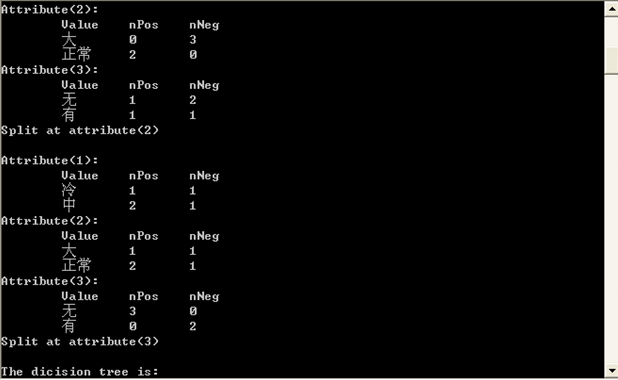
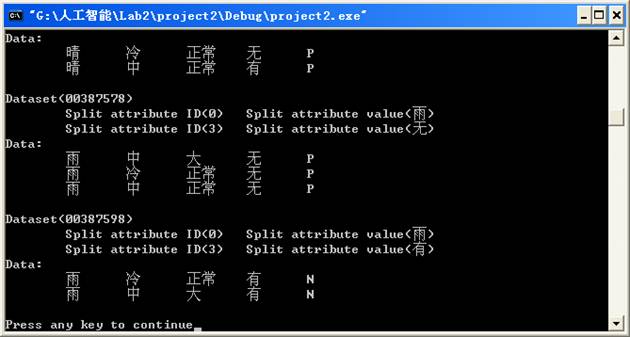

六、实验结果、分析和结论(误差分析与数据处理、成果总结等。其中,绘制曲线图时必须用计算纸或程序运行结果、改进、收获)
做这个实验的时候我遇到了很大的难度,感觉它的要求和自己的实际水平相差很大,虽然老师给了源代码,但是还有好多看不懂,我感到了自己的编程方面的能力还很不足,还需要加强的地方还有很多。通过本次试验,我学习了用Information Gain构造决策树的方法,理解并掌握构造决策树的技术要点,复习程序设计和数据结构课程的相关知识,感觉对课程有了更深入的了解,觉得自己收获了很多。虽然在实验过程中也遇到了很多困难,但在老师和同学的帮助下,顺利完成了实验。我复习了以前学过的c++方面的知识,发现自己不懂的地方实在太多,有好多学过的知识都不太记得了,深刻的认识到自己的能力的不足,有许多方面都需要好好看书,还需要多加练习。总之这次实验让我学到了很多,使我今后的学习更加顺利轻松。
